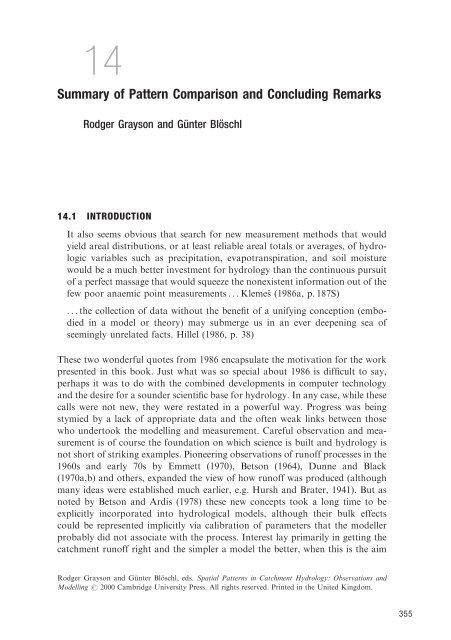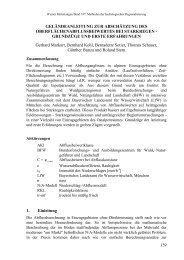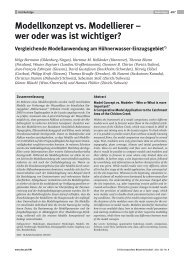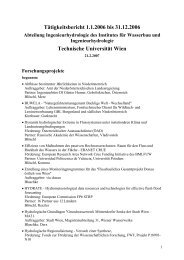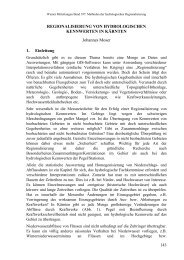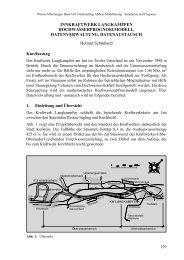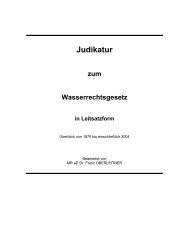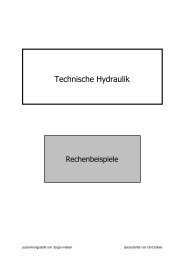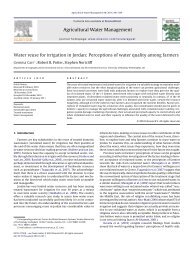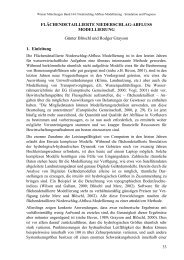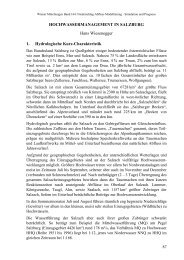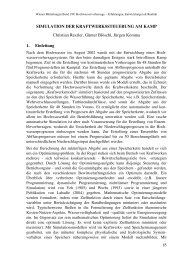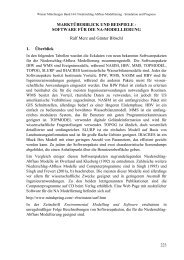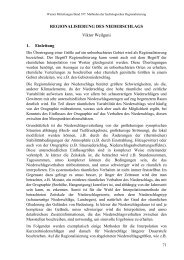Summary of Pattern Comparison and Concluding Remarks
Summary of Pattern Comparison and Concluding Remarks
Summary of Pattern Comparison and Concluding Remarks
Create successful ePaper yourself
Turn your PDF publications into a flip-book with our unique Google optimized e-Paper software.
14<br />
<strong>Summary</strong> <strong>of</strong> <strong>Pattern</strong> <strong>Comparison</strong> <strong>and</strong> <strong>Concluding</strong> <strong>Remarks</strong><br />
Rodger Grayson <strong>and</strong> Günter Blöschl<br />
14.1 INTRODUCTION<br />
It also seems obvious that search for new measurement methods that would<br />
yield areal distributions, or at least reliable areal totals or averages, <strong>of</strong> hydrologic<br />
variables such as precipitation, evapotranspiration, <strong>and</strong> soil moisture<br />
would be a much better investment for hydrology than the continuous pursuit<br />
<strong>of</strong> a perfect massage that would squeeze the nonexistent information out <strong>of</strong> the<br />
few poor anaemic point measurements ...Klemesˇ (1986a, p. 187S)<br />
...the collection <strong>of</strong> data without the benefit <strong>of</strong> a unifying conception (embodied<br />
in a model or theory) may submerge us in an ever deepening sea <strong>of</strong><br />
seemingly unrelated facts. Hillel (1986, p. 38)<br />
These two wonderful quotes from 1986 encapsulate the motivation for the work<br />
presented in this book. Just what was so special about 1986 is difficult to say,<br />
perhaps it was to do with the combined developments in computer technology<br />
<strong>and</strong> the desire for a sounder scientific base for hydrology. In any case, while these<br />
calls were not new, they were restated in a powerful way. Progress was being<br />
stymied by a lack <strong>of</strong> appropriate data <strong>and</strong> the <strong>of</strong>ten weak links between those<br />
who undertook the modelling <strong>and</strong> measurement. Careful observation <strong>and</strong> measurement<br />
is <strong>of</strong> course the foundation on which science is built <strong>and</strong> hydrology is<br />
not short <strong>of</strong> striking examples. Pioneering observations <strong>of</strong> run<strong>of</strong>f processes in the<br />
1960s <strong>and</strong> early 70s by Emmett (1970), Betson (1964), Dunne <strong>and</strong> Black<br />
(1970a,b) <strong>and</strong> others, exp<strong>and</strong>ed the view <strong>of</strong> how run<strong>of</strong>f was produced (although<br />
many ideas were established much earlier, e.g. Hursh <strong>and</strong> Brater, 1941). But as<br />
noted by Betson <strong>and</strong> Ardis (1978) these new concepts took a long time to be<br />
explicitly incorporated into hydrological models, although their bulk effects<br />
could be represented implicitly via calibration <strong>of</strong> parameters that the modeller<br />
probably did not associate with the process. Interest lay primarily in getting the<br />
catchment run<strong>of</strong>f right <strong>and</strong> the simpler a model the better, when this is the aim<br />
Rodger Grayson <strong>and</strong> Gu¨ nter Blo¨ schl, eds. Spatial <strong>Pattern</strong>s in Catchment Hydrology: Observations <strong>and</strong><br />
Modelling # 2000 Cambridge University Press. All rights reserved. Printed in the United Kingdom.<br />
355
356 R Grayson <strong>and</strong> G Blo¨ schl<br />
(Dawdy, 1969). But when used for investigative purposes, the need for models to<br />
mimic the real processes <strong>and</strong> be ‘‘right for the right reasons’’ (Klemesˇ , 1986a)<br />
becomes paramount. However, mimicking real processes adds complexity, which<br />
in turn exp<strong>and</strong>s the amount <strong>and</strong> type <strong>of</strong> data needed for testing.<br />
In the early chapters <strong>of</strong> this book we argued that in catchment hydrology, the<br />
measurement <strong>of</strong> spatial patterns is necessary to further our underst<strong>and</strong>ing <strong>of</strong><br />
hydrological processes <strong>and</strong> to properly test <strong>and</strong> develop spatially explicit hydrological<br />
models. The case studies represent some <strong>of</strong> the few attempts to test this<br />
assertion by combining detailed spatial observations <strong>and</strong> modelling in a catchment<br />
hydrology context. The studies also serve to test whether the response <strong>of</strong><br />
funding agencies <strong>and</strong> organisations to those powerful calls, that continued<br />
through to the 90s, can be vindicated. The case studies cover an extraordinary<br />
range <strong>of</strong> dominant processes, catchment sizes, data types <strong>and</strong> modelling<br />
approaches. Environments range from the semi-arid, convective storm dominated<br />
region <strong>of</strong> Arizona, through the tropical forests <strong>of</strong> the Amazon, to catchments<br />
in Australia, France, Belgium, Norway, Denmark <strong>and</strong> Canada; from the<br />
steep mountains <strong>of</strong> Austria to the rolling country <strong>of</strong> Idaho. Catchment sizes<br />
range from less than 1 hectare to more than 10,000. Data types include simple<br />
nested stream gauging data, numerous point samples <strong>of</strong> soil moisture using a<br />
number <strong>of</strong> methods, piezometric level, snow water equivalent, run<strong>of</strong>f detectors,<br />
soil chemical <strong>and</strong> vegetative indicators <strong>of</strong> recharge <strong>and</strong> discharge, <strong>and</strong> a range <strong>of</strong><br />
remote sensing techniques (satellite SAR, airborne passive microwave, multispectral<br />
data, RADAR precipitation, <strong>and</strong> aerial photography). Most measurements<br />
have been quantitative but some have been descriptive or binary. The models<br />
have also covered a wide range <strong>of</strong> dynamic modelling approaches with different<br />
distributed structures, as well as stochastic <strong>and</strong> distribution function approaches.<br />
The one thing all <strong>of</strong> these studies can claim in common is the rare honour <strong>of</strong><br />
comparing observed to simulated patterns.<br />
14.2 WHAT HAVE WE LEARNED FROM THE COMPARISONS OF OBSERVED<br />
AND SIMULATED PATTERNS?<br />
All case studies <strong>of</strong> this book have been concerned with comparing simulated <strong>and</strong><br />
observed patterns <strong>of</strong> hydrologic variables to inform modelling. A summary <strong>of</strong> the<br />
most important conclusions reached on the basis <strong>of</strong> these comparisons in each <strong>of</strong><br />
the chapters is given in Table 14.1.<br />
In the following section, we attempt to compile a bigger picture from the<br />
outcomes <strong>of</strong> these studies in terms <strong>of</strong> the more general contributions to hydrological<br />
science. These fall into three main categories related to processes, data,<br />
<strong>and</strong> modelling.<br />
Processes<br />
A number <strong>of</strong> the studies have shown that <strong>of</strong>ten, a single process dominates<br />
hydrological response in a particular catchment. This dominant process depends<br />
on the climate <strong>and</strong> other environmental factors. In the arid/semi-arid climate <strong>of</strong>
Table 14.1. <strong>Summary</strong> <strong>of</strong> findings from the patterns comparisons<br />
Chapter <strong>Pattern</strong> comparison What was learnt from the comparison<br />
4. <strong>Pattern</strong>s <strong>and</strong> RADAR precipitation versus downscaled Spatio-temporal rainfall patterns exhibit dynamic scaling behaviour.<br />
organisation in precipitation (statistically disaggregated) simulations based on large scale patterns from both With appropriate normalisation <strong>and</strong> dynamic scaling methods, both space <strong>and</strong> space-time<br />
variability can be simulated using stochastic simulation.<br />
RADAR data <strong>and</strong> atmospheric model output. (Figs 4.7, 4.9)<br />
Storm scale atmospheric models were found to simulate patterns that showed less<br />
variability in space <strong>and</strong> time than observed, indicating that the models may need some<br />
modification.<br />
5. <strong>Pattern</strong>s <strong>and</strong><br />
organisation in<br />
evaporation<br />
Point flux measurements <strong>of</strong> evaporation<br />
versus simulations from models based<br />
on remotely sensed surface temperature<br />
<strong>and</strong> surface cover. (Fig. 5.2)<br />
Reasonable agreement with surface flux stations obtained.<br />
Uncertainty in effect <strong>of</strong> heterogeneity on flux measurements <strong>and</strong> lack <strong>of</strong> directly measured<br />
patterns <strong>of</strong> evaporative flux prevented detailed analysis <strong>of</strong> predictive capability or possible<br />
model errors.<br />
State <strong>of</strong> data <strong>and</strong> knowledge <strong>of</strong> spatial interactions insufficient at present for confident<br />
spatial evaporation estimation.<br />
6. Run<strong>of</strong>f,<br />
precipitation <strong>and</strong><br />
soil moisture at<br />
Walnut Gulch<br />
Rainfall interpolated from dense raingauge<br />
network versus estimated from<br />
remotely sensed surface brightness<br />
temperature (ESTAR). (Fig. 6.12)<br />
Soil moisture measured by passive<br />
microwave versus simulated using<br />
various sources <strong>of</strong> variability <strong>and</strong><br />
different amounts <strong>of</strong> data assimilation<br />
in a distributed model. (Figs 6.13, 6.15)<br />
Remotely sensed brightness temperature looks to be a promising estimator <strong>of</strong><br />
precipitation patterns in semi-arid environments.<br />
Rainfall patterns are the dominant control on soil moisture patterns <strong>and</strong> must be<br />
represented to model hydrological response in this environment. Spatial variability at<br />
the sub-hectare scale was influential on run<strong>of</strong>f processes.<br />
Estimating soil properties from soil type deteriorated simulations <strong>of</strong> soil moisture by a<br />
distributed model as compared to using uniform soil properties.<br />
Newtonian nudging was best able to assimilate PBMR soil moisture estimates with model<br />
estimates to correct spatial simulations.<br />
The representation <strong>of</strong> channel losses is critical to predicting run<strong>of</strong>f accurately in this<br />
environment.<br />
7. Spatial snow<br />
cover processes<br />
at Ku¨ htai <strong>and</strong><br />
Reynolds Creek<br />
Aerial photographs <strong>of</strong> snow cover versus<br />
simulations from a distributed model.<br />
(Figs 7.3, 7.4, 7.5)<br />
Inclusion <strong>of</strong> topographically varied energy inputs <strong>and</strong> wind drift in a distributed model<br />
enabled the spatial variability <strong>of</strong> basic cover patterns to be reproduced. Refined<br />
representations <strong>of</strong> avalanching, wind drift <strong>and</strong> reflected <strong>and</strong> emitted radiation from<br />
adjacent areas are needed to further improve simulated patterns.<br />
(continued)<br />
357
Table 14.1 (continued)<br />
Chapter <strong>Pattern</strong> <strong>Comparison</strong> What was learnt from the comparison<br />
Observed snow water equivalent from<br />
intensive point measurements versus<br />
simulations from a distributed model.<br />
(Fig. 7.12)<br />
<strong>Pattern</strong>s <strong>of</strong> SWE could be reproduced only when the process <strong>of</strong> wind drift was simulated –<br />
this process dominates spatial patterns in a rangel<strong>and</strong> environment. Other factors such<br />
as topographic variations in energy inputs were insignificant compared to drift.<br />
8. Variable source A field survey <strong>of</strong> saturated area versus Soil moisture <strong>and</strong> wet areas cannot be retrieved from single images on vegetated surfaces.<br />
areas, soil<br />
moisture <strong>and</strong><br />
estimated pattern from the st<strong>and</strong>ard<br />
deviation, <strong>and</strong> from PCA, <strong>of</strong> multi-<br />
The hypothesis that wet areas should be identifiable as areas <strong>of</strong> low variance in multitemporal<br />
SAR images was confirmed.<br />
active microwave temporal SAR images. (Figs 8.5, 8.11) In areas where terrain variability is high, it dominates the SAR response.<br />
observations at<br />
PCA applied to multitemporal images can be used to isolate the component <strong>of</strong> the<br />
Zwalmbeek <strong>and</strong><br />
Coët-Dan<br />
Mapped soils that are characteristic <strong>of</strong><br />
wet areas versus estimated patterns from<br />
the st<strong>and</strong>ard deviation, <strong>and</strong> from PCA,<br />
<strong>of</strong> multi-temporal SAR images.<br />
(Figs 8.6, 8.8)<br />
backscatter coefficient that is dominated by variations in soil moisture, providing<br />
qualitative patterns <strong>of</strong> areas likely to be wet.<br />
9. Soil moisture<br />
<strong>and</strong> run<strong>of</strong>f<br />
processes at<br />
Soil moisture in the top 30 cm from<br />
intensively sampled point measurements<br />
versus simulated soil moisture from a<br />
Tarrawarra distributed model. (Figs 9.6, 9.9, 9.10,<br />
9.11, 9.12)<br />
A distributed model that represented the effect <strong>of</strong> spatial variability in topography on<br />
lateral surface <strong>and</strong> subsurface flow, <strong>and</strong> radiation exposure on evaporation, was able to<br />
represent the spatial <strong>and</strong> temporal variation in soil moisture.<br />
Introduction <strong>of</strong> variability in soil properties via mapping <strong>of</strong> soil type did not improve<br />
simulations.<br />
Preferential flow through cracks in the soil in Autumn needs to be represented to improve<br />
observed spatial patterns during this period.<br />
An additional soil layer needs to be represented, <strong>and</strong> better ET procedures included to<br />
further improve soil moisture estimates in the Spring.<br />
10. Storm run<strong>of</strong>f<br />
generation at<br />
Run<strong>of</strong>f occurrence from intensive network<br />
<strong>of</strong> run<strong>of</strong>f detectors versus simulated<br />
La Cuenca run<strong>of</strong>f occurrence from a distributed<br />
model (Figs 10.15, 10.16)<br />
Simulations using deterministic patterns <strong>of</strong> soil hydraulic properties could not reproduce<br />
observed patterns <strong>of</strong> run<strong>of</strong>f occurrence.<br />
Distributed models in this tropical environment could represent the functional behaviour<br />
<strong>of</strong> spatial run<strong>of</strong>f response only by combining deterministic patterns <strong>and</strong> r<strong>and</strong>om<br />
realisations <strong>of</strong> soil hydraulic properties.<br />
358
Table 14.1 (continued)<br />
Chapter <strong>Pattern</strong> comparison What was learnt from the comparison<br />
11. Shallow<br />
groundwater<br />
response at<br />
Minifelt<br />
Water levels from a dense network <strong>of</strong><br />
piezometers versus simulations from<br />
a quasi distributed model.<br />
(Figs 11.4, 11.12)<br />
Topography <strong>and</strong> soil depth alone could not reproduce observed patterns.<br />
Measured patterns <strong>of</strong> piezometric level could be simulated only through the use <strong>of</strong><br />
spatially variable soil porosity <strong>and</strong> hydraulic conductivity. These soil parameters<br />
needed to be ‘‘back-calculated’’ from spatial water table response <strong>and</strong> their patterns<br />
could not be interpreted physically.<br />
Model structure uncertainty complicated the assessment <strong>of</strong> the value <strong>of</strong> different data<br />
types for constraining the uncertainty in simulations.<br />
In the dry parts <strong>of</strong> the catchment, patterns were more useful than times series at a point<br />
for constraining the uncertainty in simulations but the reverse was true in the wet parts<br />
<strong>of</strong> the catchment.<br />
12. Groundwater–<br />
vadose zone<br />
interactions at<br />
Trochu<br />
Observations <strong>of</strong> long term recharge <strong>and</strong><br />
discharge locations based on<br />
piezometric levels <strong>and</strong> vegetative,<br />
biological <strong>and</strong> soil chemical indicators,<br />
versus simulations from an equilibrium<br />
vadose zone model linked to a<br />
distributed groundwater model.<br />
(Figs 12.6, 12.7, 12.8, 12.9, 12.10)<br />
Coupling <strong>of</strong> the vadose zone <strong>and</strong> groundwater behaviour was able to reproduce observed<br />
patterns <strong>of</strong> recharge <strong>and</strong> discharge.<br />
Recharge/discharge patterns are more dependent on local topography when strong<br />
coupling exists <strong>and</strong> on regional topography when weak coupling exists.<br />
Low bedrock transmissivities increase the area <strong>of</strong> a catchment over which coupling is<br />
important<br />
13. Towards a<br />
formal approach<br />
to calibration<br />
<strong>and</strong> validation<br />
<strong>of</strong> models using<br />
spatial data<br />
Multiple point observations <strong>of</strong> groundwater<br />
level <strong>and</strong> stream flow versus<br />
simulations from a large scale<br />
distributed model (Figs 13.5, 13.6,<br />
13.7)<br />
Predictive performance for stream gauges <strong>and</strong> wells that were not used for calibration was<br />
poor due to problems with the simulated groundwater divide.<br />
Use <strong>of</strong> even limited spatial data provides a severe test for distributed models <strong>and</strong> should<br />
become part <strong>of</strong> modelling practice <strong>of</strong> credibility <strong>of</strong> results is to be assured.<br />
359
360 R Grayson <strong>and</strong> G Blo¨ schl<br />
Walnut Gulch (Chapter 6) rainfall space-time variability was vastly more important<br />
than other controls, based on an analysis <strong>of</strong> rainfall data at the sub-hectare<br />
scale <strong>and</strong> a sensitivity analysis using the KINEROS model. For the very different<br />
climate <strong>of</strong> Reynolds Creek (Chapter 7) it was demonstrated that wind drift is by<br />
far the most important process affecting space-time patterns <strong>of</strong> snow water<br />
equivalent, by comparing observed snow water equivalent patterns with two<br />
simulated scenarios, with <strong>and</strong> without a representation <strong>of</strong> snow drift. In the<br />
humid climate <strong>of</strong> the Tarrawarra catchment (Chapter 9) saturated source area<br />
run<strong>of</strong>f was the dominant run<strong>of</strong>f mechanism as concluded from simple initial<br />
analyses <strong>of</strong> the observed TDR soil moisture patterns <strong>and</strong> later confirmed by<br />
Thales simulations. The simulations also confirmed that subsurface water movement<br />
changes abruptly in spring <strong>and</strong> autumn. During summer (dry), vertical<br />
water movement was dominant while in winter (wet), lateral water movement<br />
was dominant. Finally, a comparison <strong>of</strong> simulated <strong>and</strong> observed recharge/discharge<br />
patterns in the Prairie climate <strong>of</strong> Trochu (Chapter 12) indicated that<br />
recharge <strong>and</strong> discharge patterns were controlled by the coupling <strong>of</strong> the regional<br />
aquifer with the surface through the unsaturated zone, which dominated the local<br />
water budget. This finding was corroborated by a sensitivity study comparing<br />
scenarios with <strong>and</strong> without coupling to observed recharge/discharge patterns.<br />
The scenario without coupling could be made to match observed patterns only<br />
when unrealistically high values <strong>of</strong> recharge were assumed.<br />
<strong>Comparison</strong>s <strong>of</strong> simulated <strong>and</strong> observed patterns have also shed light on the<br />
nature <strong>of</strong> space-time variability <strong>of</strong> hydrologic variables that probably would not<br />
have been possible by simple visualisation <strong>of</strong> the data alone. For example, analyses<br />
<strong>of</strong> RADAR rainfall data in Chapter 4 suggested that the space-time variability<br />
<strong>of</strong> rainfall is characterised by dynamic scaling, i.e. the rainfall fluctuations<br />
in space <strong>and</strong> time can be represented by a power law when plotted against scale<br />
after appropriate renormalisation. This property was used for generating rainfall<br />
patterns by means <strong>of</strong> stochastic simulations (downscaling) that when compared<br />
to RADAR rainfall patterns, looked realistic. Analyses <strong>of</strong> remotely sensed<br />
(ESTAR) soil moisture patterns in Walnut Gulch (Chapter 6) indicated that,<br />
following a rainstorm, these patterns were organised but this organisation<br />
faded away after the storm, <strong>and</strong> the pattern became r<strong>and</strong>om. The authors suggested<br />
that this change-over is a reflection <strong>of</strong> the changing control on soil moisture<br />
<strong>of</strong> rainfall versus patterns <strong>of</strong> surface soil characteristics. A similar changeover<br />
in the variability <strong>of</strong> soil moisture, however this time on a seasonal basis, was<br />
identified at Tarrawarra (Chapter 9). Spatially organised patterns that were<br />
related to terrain occurred in winter while spatially r<strong>and</strong>om patterns occurred<br />
in summer. This change-over was identified by visual inspection <strong>of</strong> the TDR<br />
measurements <strong>and</strong> further explained by comparison with model results. In La<br />
Cuenca (Chapter 10) where infiltration excess <strong>and</strong> pipe flow were important<br />
run<strong>of</strong>f mechanisms, the type <strong>of</strong> spatial variability in soil hydraulic conductivity<br />
was inferred from a comparison <strong>of</strong> observed patterns <strong>of</strong> frequency <strong>of</strong> run<strong>of</strong>f<br />
occurrence with a number <strong>of</strong> scenarios with different types <strong>of</strong> soil variability<br />
represented. It was found that a combined deterministic (by soil type) <strong>and</strong>
<strong>Summary</strong> <strong>of</strong> <strong>Pattern</strong> <strong>Comparison</strong> <strong>and</strong> <strong>Concluding</strong> <strong>Remarks</strong> 361<br />
stochastic pattern <strong>of</strong> conductivity produced patterns <strong>of</strong> run<strong>of</strong>f occurrence that<br />
were most similar to the observed patterns.<br />
Clearly, the detail <strong>of</strong> these insights into catchment behaviour was made possible<br />
by the availability <strong>of</strong> measured patterns.<br />
Data<br />
While it is clear that the patterns were useful in their own right, several studies<br />
showed that they are even more useful if used in combination with time series<br />
data. <strong>Pattern</strong>s <strong>and</strong> time series are therefore complementary <strong>and</strong> the case studies<br />
have shown that these different types <strong>of</strong> data (space variability <strong>and</strong> time variability,<br />
respectively) can be used to identify different properties <strong>of</strong> the catchment<br />
behaviour. In Chapter 7 conventional run<strong>of</strong>f hydrographs were used to identify<br />
the snow melt run<strong>of</strong>f volume from the catchment. In a similar fashion, run<strong>of</strong>f was<br />
used to close the water balance <strong>of</strong> the Tarrawarra catchment (Chapter 9) by<br />
enabling an estimation <strong>of</strong> deep drainage into bedrock. In La Cuenca (Chapter<br />
10) run<strong>of</strong>f hydrographs were used to complement the spatial patterns, but this<br />
time at the event scale, to calibrate the Manning roughness parameter. In each <strong>of</strong><br />
these cases, the information available in the time series was used for things that<br />
could not be well identified from the spatial data. Use <strong>of</strong> the two types <strong>of</strong><br />
information together was the key to realistic simulation <strong>of</strong> space-time patterns<br />
<strong>of</strong> processes in each study. Similarly, in Minifelt (Chapter 11) soil porosity<br />
(related to the dynamics) was calibrated from mainly time series data (borehole<br />
data <strong>of</strong> the shallow groundwater table), while hydraulic conductivity was calibrated<br />
from mainly snapshots <strong>of</strong> spatial patterns <strong>of</strong> the groundwater table. It was<br />
the complementary nature <strong>of</strong> spatial pattern <strong>and</strong> time series data that enabled<br />
successful modelling.<br />
Perhaps surprisingly, patterns <strong>of</strong> binary data were used in about half <strong>of</strong> the<br />
case studies; i.e. in the trade <strong>of</strong>f between spatial resolution <strong>and</strong> information from<br />
a particular point (discussed in Chapter 2), the scales were tipped towards spatial<br />
resolution. All <strong>of</strong> these studies showed that a wealth <strong>of</strong> information can be<br />
revealed from a binary pattern. In Ku¨ htai (Chapter 7) snow cover patterns<br />
(snow/no snow) were used; in Zwalmbeek <strong>and</strong> Coe¨ t-Dan (Chapter 8) patterns<br />
<strong>of</strong> saturated source areas (saturated/not saturated) were used; in La Cuenca<br />
(Chapter 10) patterns <strong>of</strong> run<strong>of</strong>f occurrence (for a single event, run<strong>of</strong>f occurred/<br />
did not occur) were used; <strong>and</strong> in Trochu (Chapter 12) patterns <strong>of</strong> recharge/discharge<br />
(either recharge or discharge) were used. The data used at Trochu are<br />
particularly interesting as they have been derived from qualitative observation<br />
including chemical/vegetation indicators. These indicators integrate over time so<br />
are representative <strong>of</strong> the long-term mean <strong>of</strong> recharge/discharge conditions (To´ th,<br />
1966). Although water tables for a given point in time (snap shots) would have<br />
been easier to measure, the binary recharge/discharge data were much more<br />
appropriate to test the equilibrium vadose zone model used in Chapter 12.<br />
The spatial variability <strong>of</strong> physical soil properties is particularly critical in<br />
catchment hydrology, yet we have relatively poor ways <strong>of</strong> estimating them at<br />
the catchment scale. It is therefore not surprising that a number <strong>of</strong> case studies in
362 R Grayson <strong>and</strong> G Blo¨ schl<br />
this book have scrutinised the reliability <strong>of</strong> soils data <strong>and</strong> their effect on the<br />
representation <strong>of</strong> catchment response. For Walnut Gulch (Chapter 6), where<br />
the infiltration excess run<strong>of</strong>f mechanism dominates, TOPLATS was used to<br />
simulate scenarios <strong>of</strong> soil moisture patterns. One <strong>of</strong> the scenarios was based on<br />
uniform soil hydraulic properties, while the other scenario used pedotransfer<br />
functions from the literature to estimate the soil hydraulic properties from<br />
mapped soil type. A comparison <strong>of</strong> the soil moisture patterns from the two<br />
scenarios with observed soil moisture patterns from airborne PBMR, indicated<br />
that the one based on soil type was too patchy <strong>and</strong> the scenario using uniform<br />
soil properties was more consistent with the observations. At Tarrawarra<br />
(Chapter 9) one scenario used soil type to spatially distribute hydraulic conductivity<br />
measurements, assuming uniform conductivity within each soil type zone.<br />
This scenario produced artificially high soil moisture values at the interface <strong>of</strong> the<br />
soil types that could be identified by comparisons with observed soil moisture<br />
patterns. A similar comparison at La Cuenca (Chapter 10) indicated that the<br />
assumption <strong>of</strong> uniform conductivity in each <strong>of</strong> their three l<strong>and</strong> types was not<br />
appropriate <strong>and</strong> a r<strong>and</strong>om component had to be added to the deterministic<br />
pattern imposed by l<strong>and</strong> type. Clearly, the variability <strong>of</strong> soil physical properties<br />
within soil types can be as large or larger than the variability between soil types.<br />
This suggests that the widespread practice in distributed modelling <strong>of</strong> allocating<br />
soil hydraulic properties on the basis <strong>of</strong> soils type (using either pedo-transfer<br />
functions or typical measurements from each soil) is likely to result in poor<br />
simulations <strong>of</strong> patterns in soil moisture <strong>and</strong> run<strong>of</strong>f.<br />
With respect to data issues, the case studies have highlighted the value <strong>of</strong><br />
complementary data (spatial patterns <strong>and</strong> time series), the utility <strong>of</strong> binary patterns<br />
(which are <strong>of</strong>ten simple to collect compared to quantitative patterns) <strong>and</strong><br />
some particular problems in representing soil properties in models. We next<br />
address the utility <strong>of</strong> these data for informing model development.<br />
Modelling<br />
An important reason for comparing simulated <strong>and</strong> observed patterns was to<br />
assess the credibility <strong>of</strong> the distributed catchment models, i.e. how well can they<br />
represent individual processes that operate in the catchment, <strong>and</strong> which processes<br />
are perhaps not represented very well? This assessment resulted in suggestions for<br />
changes in model structure or model parameters (or perhaps inputs) that are<br />
needed to refine the model simulations.<br />
Most <strong>of</strong> the chapters in this book concluded that the models worked quite<br />
well, albeit after calibration, <strong>and</strong> that the main processes were very well represented.<br />
However, they also concluded that it is possible to use subtle differences<br />
between simulated <strong>and</strong> observed patterns to inform us about how the models<br />
could be improved. At Ku¨ htai (Chapter 7), for example, the comparison <strong>of</strong> snow<br />
cover patterns suggested that the model underestimated snow water equivalent in<br />
cirques. This was traced back to not representing emitted radiation from surrounding<br />
terrain. Similarly, a tendency to overestimate (<strong>and</strong> underestimate) snow<br />
cover on south facing (<strong>and</strong> north facing) slopes, was interpreted as evidence that
<strong>Summary</strong> <strong>of</strong> <strong>Pattern</strong> <strong>Comparison</strong> <strong>and</strong> <strong>Concluding</strong> <strong>Remarks</strong> 363<br />
the model should account for the dependence <strong>of</strong> snow albedo on energy input. At<br />
Reynolds Creek (Chapter 7) the comparison <strong>of</strong> simulated <strong>and</strong> observed patterns<br />
<strong>of</strong> snow water equivalent suggested that the simulated drift is more sharply<br />
defined than the observed drift. This was traced back to differences in the<br />
wind conditions between the year used for calibrating the model <strong>and</strong> the year<br />
where the model was tested. A suggested remedy was to use a more sophisticated<br />
deterministic wind drift model that takes into account differences in wind conditions<br />
from year to year, although more data would probably be needed to<br />
properly test this idea. At Tarrawarra (Chapter 9) subtle differences between<br />
simulated <strong>and</strong> observed rates <strong>of</strong> the temporal change in soil moisture patterns<br />
in autumn suggested that the lateral soil hydraulic conductivity may in fact<br />
change with time. This was indicated by faster subsurface redistribution in<br />
early autumn than in late autumn. It was suggested that this was due to temporal<br />
changes in conductivity caused by the closing <strong>of</strong> cracks that had formed over<br />
summer, thereby reducing lateral conductivity. However, testing <strong>of</strong> this would<br />
need additional data. At Minifelt (Chapter 11) where shallow water table patterns<br />
were used to calibrate the spatial patterns <strong>of</strong> soil physical properties in<br />
TOPMODEL, it was difficult to physically interpret the calibrated patterns.<br />
This was suggested to be evidence that there may be structural problems with<br />
the TOPMODEL approach for Minifelt, <strong>and</strong> relaxing the TOPMODEL assumptions<br />
may improve spatial predictions. Also, the uncertainty analysis based on<br />
spatially uniform soils parameters (which is a more common TOPMODEL application)<br />
gave different predictions <strong>and</strong> different uncertainty bounds depending on<br />
whether time series <strong>of</strong> borehole data or patterns <strong>of</strong> piezometer data were used to<br />
constrain the model parameters. This also suggested that there may be substantial<br />
structural uncertainty with TOPMODEL as applied in the Minifelt example.<br />
In about half <strong>of</strong> the case studies (Reynolds Creek, Tarrawarra, La Cuenca,<br />
Minifelt) comparisons <strong>of</strong> simulated <strong>and</strong> observed patterns were used not only to<br />
assess the reliability <strong>of</strong> the model, but also to calibrate some <strong>of</strong> the model parameters<br />
as mentioned above. Both assessment <strong>and</strong> calibration were done by a<br />
visual pattern comparison. Some <strong>of</strong> the case studies, however, used more objective<br />
<strong>and</strong> sophisticated methods for model testing <strong>and</strong> parameter identification. At<br />
Walnut Gulch (Chapter 6) four-dimensional data assimilation (4DDA) methods<br />
were used to update the model state variables <strong>of</strong> the TOPLATS model by using<br />
remotely sensed (PBMR) <strong>and</strong> in situ point measurements <strong>of</strong> soil moisture. It was<br />
concluded that 4DDA (already being in operational use in atmospheric modelling)<br />
holds substantial promise for operational use in spatially distributed hydrological<br />
modelling. There is an obvious parallel with operational run<strong>of</strong>f<br />
forecasting, where updating model state variables (albeit in the time domain) is<br />
common practice today. A formal parameter uncertainty analysis was performed<br />
in Chapter 11 based on the GLUE procedure which gave a very useful assessment<br />
<strong>of</strong> the reliability <strong>of</strong> model parameters <strong>and</strong> helped define the value <strong>of</strong> various data<br />
types in constraining the model parameter uncertainty. Although the method is<br />
computationally dem<strong>and</strong>ing it can h<strong>and</strong>le nonlinear models <strong>and</strong> it can make use<br />
<strong>of</strong> observed spatial patterns. In Chapter 11, parameter uncertainty was plotted
364 R Grayson <strong>and</strong> G Blo¨ schl<br />
against the topographic wetness index, which allowed differences in uncertainty<br />
between the gully <strong>and</strong> ridge areas <strong>of</strong> the catchment to be examined. The validation<br />
tests were taken even further in Chapter 13 for the Karup catchment. This<br />
was a significantly larger application than the case study chapters in the book <strong>and</strong><br />
focussed on use <strong>of</strong> models in a more practical context. The MIKE-SHE model<br />
was calibrated <strong>and</strong> than validated based on a formal procedure presented by the<br />
author, using data from a number <strong>of</strong> internal stream gauges <strong>and</strong> boreholes. In<br />
this respect it was more typical <strong>of</strong> what may be possible in practical applications<br />
<strong>of</strong> spatially distributed models outside small research catchments. The author<br />
concluded from the comparisons <strong>of</strong> observed <strong>and</strong> simulated hydrologic variables<br />
at a number <strong>of</strong> locations, that when a formal framework <strong>of</strong> validation tests is set<br />
a priori, it may be difficult to meet the validation criteria in practice. He concluded<br />
that formal protocols are needed for model validation <strong>and</strong> that implementation<br />
<strong>of</strong> these for practical applications will require more dialogue between<br />
model developers, users <strong>and</strong> the managers who use simulations in their decision<br />
making, so that capabilities <strong>and</strong> limitations are clearly articulated.<br />
In this section, we have summarised in some detail, the conclusions <strong>of</strong> the case<br />
studies, highlighting where the use <strong>of</strong> measured patterns, <strong>of</strong>ten in combination<br />
with more traditional measurements, were useful in explaining processes <strong>and</strong><br />
developing models within relatively small research catchments. As discussed in<br />
Chapter 13, the larger scale, more practically oriented problems to which distributed<br />
models are applied can also benefit from the use <strong>of</strong> pattern data, but that<br />
such data are much less common in the ‘‘real world’’. We predict that in the<br />
coming years, more effort will be placed on collecting <strong>and</strong> using patterns at the<br />
larger scale so that the benefits discussed in the case studies can be realised in<br />
more practical applications.<br />
14.3 OUTLOOK<br />
The use <strong>of</strong> spatial patterns in catchment hydrology is in its infancy, but initial<br />
results are encouraging <strong>and</strong> provide sound reasons to believe that there are great<br />
improvements to be made in our underst<strong>and</strong>ing <strong>of</strong> catchment hydrological processes;<br />
<strong>and</strong> in quantifying the way they affect, <strong>and</strong> are affected by, spatial variability<br />
across a range <strong>of</strong> scales. More specifically, the work presented in this book<br />
illustrates that to realise these improvements, we need appropriate data.<br />
Appropriate meaning that it tells us about system behaviour, tests critical assumptions<br />
in our underst<strong>and</strong>ing <strong>and</strong> in our models <strong>of</strong> that underst<strong>and</strong>ing, <strong>and</strong> provides<br />
enough information to resolve the problems <strong>of</strong> non-uniqueness <strong>and</strong><br />
parameter identifiability inherent in complex models. Spatial patterns <strong>of</strong> hydrological<br />
response are an appropriate data source in this respect. So while collecting<br />
<strong>and</strong> collating large spatial data sets will be important to the development <strong>of</strong><br />
spatial models <strong>and</strong> improved process underst<strong>and</strong>ing, just where are the specific<br />
areas where significant progress can be made? In the following few paragraphs we<br />
provide a brief assessment <strong>of</strong> key areas.
<strong>Summary</strong> <strong>of</strong> <strong>Pattern</strong> <strong>Comparison</strong> <strong>and</strong> <strong>Concluding</strong> <strong>Remarks</strong> 365<br />
14.3.1 Improvements to Model Inputs<br />
Numerous hydrological studies spanning over many decades have shown the<br />
importance <strong>of</strong> precipitation on hydrological response. Now with RADAR estimates<br />
<strong>of</strong> spatial patterns in precipitation <strong>and</strong> new methods such as those described<br />
in Chapter 4 for characterising space-time variability, we are on the threshold <strong>of</strong> a<br />
major advance in the use <strong>of</strong> spatial precipitation information in distributed models.<br />
To fully realise the potential <strong>of</strong> this information, we may well need changes to<br />
model structure, <strong>and</strong> will certainly need changes in the attitudes <strong>of</strong> hydrological<br />
modellers who have been firmly wedded to the use <strong>of</strong> raingauge data for calibration<br />
<strong>and</strong> testing. Several <strong>of</strong> the case studies showed that simple binary patterns can<br />
be powerful tests <strong>of</strong> distributed models <strong>and</strong> provide useful information on threshold<br />
phenomena such as saturated source areas. There would appear to be further<br />
scope for use <strong>of</strong> this type <strong>of</strong> data, but again some changes in attitude towards<br />
‘‘non-quantitative’’ data, <strong>and</strong> possibly changes to model structure, may be needed.<br />
At least in the immediate future, remotely sensed (RS) data can be thought <strong>of</strong> in<br />
this context <strong>and</strong> might be best used to assist in reducing the degrees <strong>of</strong> freedom in<br />
distributed hydrological models by providing patterns, rather than absolute<br />
values, <strong>of</strong> important inputs <strong>and</strong> parameters. Model structures are being improved<br />
to better exploit pattern data via improved s<strong>of</strong>tware engineering (such as integration<br />
with GIS platforms) <strong>and</strong> this should serve as encouragement for the development<br />
<strong>of</strong> hydrological algorithms that are specifically intended for the scale <strong>and</strong><br />
nature <strong>of</strong> RS data. Chapter 5 clearly illustrated that we have a long way to go in<br />
fully underst<strong>and</strong>ing <strong>and</strong> being able to represent spatial patterns <strong>of</strong> evaporation.<br />
Given that evaporation can be over 90 % <strong>of</strong> the water budget in some environments,<br />
it is obvious that studies into dealing with spatial measurement <strong>and</strong> the role<br />
<strong>of</strong> l<strong>and</strong> surface heterogeneity will continue to be critical to improvements in,<br />
particularly, large-scale models.<br />
Spatially distributed modelling requires the use <strong>of</strong> interpolation for a number<br />
<strong>of</strong> purposes, including the matching <strong>of</strong> model <strong>and</strong> measurement scales <strong>of</strong> information<br />
used for input <strong>and</strong> testing. There is a need for improved interpolation<br />
methods that better enable us to incorporate our underst<strong>and</strong>ing <strong>of</strong> physical<br />
phenomena. While there are a range <strong>of</strong> methods already available, these need<br />
to be improved in their ability to represent organisation in spatial patterns <strong>of</strong><br />
hydrological importance.<br />
14.3.2 Improvements to Model Testing<br />
It is envisaged that comparisons between observed <strong>and</strong> simulated patterns will<br />
eventually become part <strong>of</strong> st<strong>and</strong>ard procedures for model testing. As well as<br />
needing the observed patterns, we also need improved quantitative techniques<br />
for comparing the similarities <strong>and</strong> differences between patterns. Some simple<br />
methods have been presented at the end <strong>of</strong> Chapter 3, but few <strong>of</strong> these have so<br />
far been used in practice. With rich areas <strong>of</strong> research on topics such as pattern<br />
recognition, we expect that the sophistication <strong>of</strong> pattern comparisons will greatly
366 R Grayson <strong>and</strong> G Blo¨ schl<br />
increase as hydrologists come to realise the value <strong>of</strong> patterns for model development<br />
<strong>and</strong> testing. Comprehensive uncertainty analysis also needs to be further<br />
developed for spatially distributed models. The potential <strong>of</strong> these methods for<br />
assessing the separate sources <strong>of</strong> uncertainty (input information, parameter<br />
values, model structure <strong>and</strong> data used in testing) is large, but at present they<br />
are not computationally tractable for most distributed models. Methodological<br />
developments as well as improvements in computer power are likely to lead to<br />
wider use <strong>of</strong> such techniques.<br />
14.3.3 Challenges for Model Conceptualisation<br />
The primary challenge <strong>of</strong> hydrologists has been, <strong>and</strong> remains, the prediction<br />
<strong>of</strong> hydrological response in ‘‘ungauged’’ areas – i.e. areas for which we have no<br />
hydrological response information. There is still a need to improve methods for<br />
generalising results from small catchments such as those described in this book,<br />
to other catchments; from small catchments to large catchments; <strong>and</strong> for being<br />
able to predict hydrological response under changed l<strong>and</strong> use <strong>and</strong> climatic conditions<br />
in catchments <strong>of</strong> all sizes. All <strong>of</strong> these needs can be met only with better<br />
underst<strong>and</strong>ing <strong>and</strong> representation <strong>of</strong> fundamental processes, <strong>and</strong> their spatial<br />
variability across a range <strong>of</strong> scales. Distributed modelling generally has moved<br />
beyond just trying to scale up small catchment models to large scales because <strong>of</strong><br />
problems with identifiability <strong>and</strong> scale dependence. As has been suggested for<br />
some time by many authors, we need models for a range <strong>of</strong> scales that are<br />
parsimonious, but that reflect the manifestation <strong>of</strong> important processes at<br />
those different scales. In moving beyond the notion <strong>of</strong> ‘‘trying to model everything’’<br />
we should be developing methods to identify dominant processes that<br />
control hydrological response in different environments (l<strong>and</strong>scapes <strong>and</strong> climates)<br />
<strong>and</strong> at different scales, <strong>and</strong> then develop models to focus on these dominant<br />
processes (a notion we might call the ‘‘Dominant Processes Concept’’<br />
(DPC)). This would provide a framework for the development <strong>and</strong> application<br />
<strong>of</strong> techniques specially designed to deal with those controls <strong>and</strong> help to avoid<br />
some <strong>of</strong> the overparameterisation problems that occur when processes that are<br />
not important are represented in models. Developments along the lines <strong>of</strong> the<br />
DPC may help with the generalisation problems that have haunted hydrologists<br />
since the science began.<br />
14.4 FINAL REMARKS<br />
As mentioned in the introduction, there have been many calls for data collection<br />
<strong>and</strong> analysis to go h<strong>and</strong> in h<strong>and</strong>, for improved underst<strong>and</strong>ing <strong>of</strong> processes,<br />
<strong>and</strong> for the scientific endeavour <strong>of</strong> measurement to be recognised. There is<br />
a range <strong>of</strong> evidence that these calls have elicited a response. For example,<br />
Water Resources Research has had ‘‘data notes’’ for some time (Hornberger,<br />
1994) <strong>and</strong> the number being published is increasing. There is an increasing<br />
awareness that the development <strong>of</strong> a spatial model is not <strong>of</strong> itself useful, unless
<strong>Summary</strong> <strong>of</strong> <strong>Pattern</strong> <strong>Comparison</strong> <strong>and</strong> <strong>Concluding</strong> <strong>Remarks</strong> 367<br />
it can be properly tested so that it can provide more credible predictions, or more<br />
insight into process underst<strong>and</strong>ing. Large field campaigns are continuing <strong>and</strong><br />
the valuable role <strong>of</strong> smaller catchment, process-focussed, studies is being recognised<br />
as the researchers have integrated their work with theoretical <strong>and</strong> modelling<br />
developments to ensure the results contribute to a wider underst<strong>and</strong>ing<br />
<strong>of</strong> patterns <strong>of</strong> hydrological variability. We hope that the case studies presented<br />
in this book, <strong>and</strong> the broader conclusions from this extraordinary range <strong>of</strong><br />
studies, have unequivocally illustrated the value <strong>of</strong> this investment, <strong>and</strong> act as<br />
encouragement for more, <strong>and</strong> more innovative, studies into spatial patterns in<br />
catchment hydrology.


